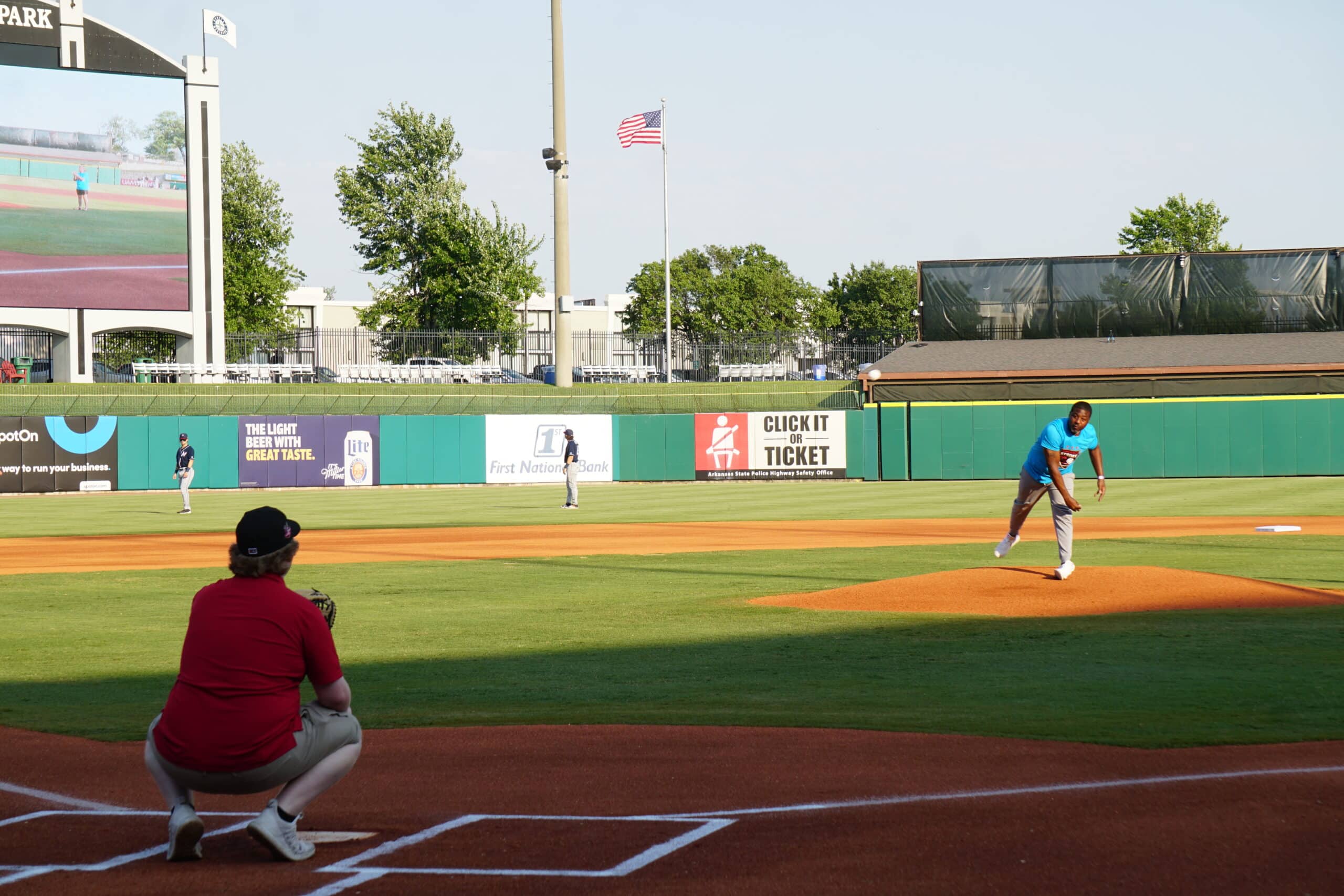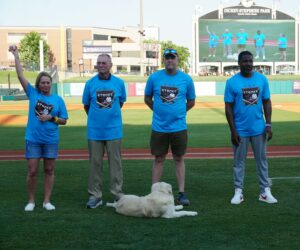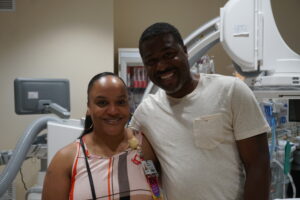View Larger Image

Ray Robinson III throws a strike against stroke at the Arkansas Travelers game held at Dickey-Stephens Park on May 19.
Image by Benjamin Waldrum
Survivor Throws Strike Against Stroke, Says Family History “Number-One Thing”
| Ray Robinson III normally doesn’t hesitate. When he stepped up to the mound at Dickey-Stephens Park in North Little Rock on May 19 for UAMS Strike Out Stroke night, Robinson immediately went into a pitcher’s windup and fired a ceremonial first-pitch strike across the plate as the crowd cheered.
But in the early morning of July 7, 2020, Robinson hesitated. When he called his wife Alyssa’s name with a slurring voice, he didn’t think he was having a stroke.
For Robinson, 42, of Little Rock, it was a typical evening. He returned home from work, had dinner, played with his daughter Alice, 10, and said goodnight. After laying down, he called his wife’s name, and she immediately knew something was wrong.
“I’ve been through this before with my grandmother, who had a stroke,” said Alyssa Robinson, a registered nurse and project manager for UAMS e-Link. “That’s why I knew, when he called my name that night, I knew it was a stroke in the dark.”
Robinson’s face drooped on his left side, and he was unable to move his left arm or leg. Immediately, his wife called 911. Once the ambulance was near, she had Alice flicker the front porch lights on and off so that they could find the house.
“My whole left side was flaccid, but I thought I could still get up,” Robinson said. “I told my wife, you’re wasting your time calling these people, there’s nothing wrong with me.”
The EMTs wanted to take Robinson to the nearest available hospital, but Alyssa Robinson insisted on UAMS, which has the only certified Comprehensive Stroke Center in central Arkansas. UAMS also has the state’s only neurointensivists – specialists in the ICU prepared for neurological emergencies – and vascular neurologists trained in stroke care. On the way to the hospital, Ray Robinson joked with the EMTs and kept a positive outlook.
Meanwhile, UAMS mobilized its stroke team of emergency physicians, nurses and neurologists. They met Robinson immediately upon arrival and, after a quick assessment, administered alteplase, a powerful clot-busting drug. A team led by Mudassar Kamran, M.D., performed a mechanical thrombectomy and reopened Robinson’s artery to remove a blood clot and restore blood flow.
Robinson stayed at UAMS for 11 days before entering acute rehab. “I didn’t know what Ray I was going to get back,” his wife said. “But whatever Ray it was, I was ready for it.”
Since then, Robinson has focused on gaining strength and leading a healthier lifestyle. He still does physical therapy at home, including yoga and speech therapy. He continues to have some difficulty with his left side, but that doesn’t stop him from living life to the fullest.
His top goal in recovery has been to ride his bike again with his daughter. Although it is still a work in progress, he continues to work at it.
“She smokes him every time,” Alyssa Robinson said, laughing.
On May 17, Ray Robinson returned to UAMS for the first time since his stroke to meet the team that helped save his life. Waiting for him were Marzella Backus, MNSc, RN, director of stroke services; Sanjeeva Onteddu, M.D., medical director; a host of nurses and staff – and Kamran.
“I’m going to have to take you to lunch, bro!” Robinson said as he hugged Kamran.

Robinson hugs Mudassar Kamran, M.D., who performed the surgery to remove a blood clot and restore blood flow.Benjamin Waldrum
“I’m so glad it worked out well for him,” Kamran said. “I was just one piece in the whole puzzle. We have a whole team here, and all of us came together to help him.”
Days later, Robinson and three other stroke survivors were on the field for Strike Out Stroke night at the ballpark, sponsored by the UAMS Digital Health & Innovation Stroke Program, formerly known as AR-SAVES. They stood together outside the Travelers dugout, each holding a commemorative baseball, and waved to the crowd as their stories were told over loudspeaker.
Tara Wright of Camden is a wife and mother who received lifesaving treatment at Ouachita County Medical Center in Camden through the UAMS stroke program and was transported to UAMS.
Retired Army Lt. Gen. George Crocker of Clinton received stroke treatment quickly at Ozark Health Medical Center in Clinton, also through the UAMS stroke program, and then further intervention at UAMS.
Michael Pafford, M.D., of Benton, is medical director of the hospitalist program at Saline Memorial Hospital in Benton. He suffered a brain stem stroke and was treated at his own hospital. He was then transferred to UAMS for expert stroke care. Their inspiring recoveries are a testament to the importance of getting treatment right away.
Arkansas ranks 13th in the nation in stroke death rates after many years in first place. The UAMS Digital Health Stroke Program provides 59 Arkansas hospitals with round-the-clock access to stroke neurologists who can quickly assess whether a stroke patient can benefit from a clot-busting drug like alteplase. The program, part of the UAMS Institute for Digital Health & Innovation, has treated more than 3,200 patients with alteplase through its network of hospitals.

Robinson, at right, was joined on the field by three other stroke survivors: (from left) Tara Wright, retired Lt. Gen. George Crocker and Michael Pafford, M.D.Benjamin Waldrum
This was the 10th year the UAMS stroke program organized the event to raise awareness of stroke and educate the public about stroke symptoms and risk. Volunteers, wearing bright blue T-shirts that showed stroke signs, handed out free T-shirts and tossed brain-shaped stress toys to the crowd.
Lori Berry, MNSc, RN, the program’s director of operations, helped Robinson walk to the mound to deliver the first pitch. Afterward, she spoke on the importance of getting treatment quickly.
“The most important message is to get help as soon as you have any signs or symptoms of a stroke,” Berry said. “Don’t wait, call 911 right away. Most Arkansans are within a 30-minute drive to a stroke-ready hospital, so don’t wait for symptoms to get better or go away – seek treatment immediately.”
Robinson’s stroke was a result of protein S deficiency, a condition that makes it more likely for a person to develop blood clots. Today, he encourages others to learn their family’s health history.
“Just know your family history, that’s the number one thing,” Robinson said. “Some diseases, it doesn’t matter what you eat, or how much you exercise, it’s just in your genes.”
“It’s a great moment for me to be here,” he said, “because I could be six feet deep right now.”
